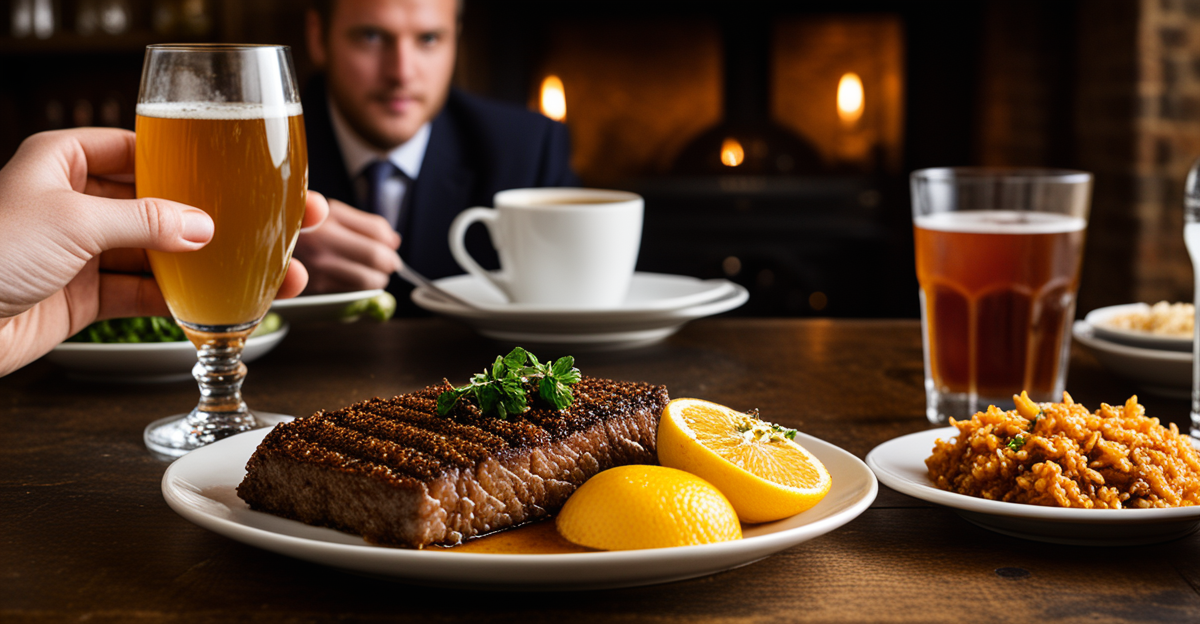Beverage Pairing Principles for Traditional UK Meals
Understanding beverage pairing with UK cuisine involves recognizing the balance between flavours and textures typical of British cooking. Traditional dishes often feature hearty, robust tastes paired beautifully with drinks that enhance, rather than overpower. The pairing rationale centers on complementing or contrasting the main ingredients to elevate the dining experience.
Key principles include considering the weight and intensity of the dish. For example, rich, meaty meals like roast beef benefit from full-bodied wines or malty ales that match the dish’s strength. Conversely, lighter dishes such as fish and chips align well with crisp, refreshing beverages that cleanse the palate.
Topic to read : What Unique Ingredients Can Transform Your Traditional British Dishes?
Texture plays a vital role. Dishes with creamy or buttery elements can be harmonized with drinks that bring acidity or effervescence. Additionally, the occasion and meal type influence pairing choices. A casual pub lunch may call for traditional ales or straightforward cider, while a formal dinner might involve carefully selected wines or sophisticated soft drinks.
Recognizing these principles equips you to select beverages that not only suit the meal but also enhance the overall enjoyment of classic UK meals.
Also read : How Can Traditional UK Cookery Influence Modern Culinary Trends?
Beverage Pairing Principles for Traditional UK Meals
Understanding beverage pairing with UK cuisine begins with recognising how flavours and textures work together. British cooking often features hearty, robust flavours — rich gravies, roasted meats, and creamy vegetables. These elements require drinks that can either complement or cut through the richness. For instance, a full-bodied ale pairs well with savory roasts because it balances the meatiness without overpowering it. Similarly, the carbonation in certain beverages can refresh the palate when faced with creamy or heavy textures.
The pairing rationale also considers traditional drinking occasions. Formal meals may lean towards classic wines or refined ciders, while casual lunches might call for lighter beers or soft drinks. This flexibility respects the context of the meal, something embedded in British dining culture. Seasonal shifts also impact beverage choice; lighter white wines are popular in summer to reflect lighter meals, whereas deeper reds suit colder months alongside roast dinners.
When pairing beverages for UK dishes, consider the main ingredients’ intensity and seasoning, the sauce or accompaniments, and the event setting. These factors define how successful the drink matches with the meal, ensuring a balanced and enjoyable dining experience.
Beverage Pairing Principles for Traditional UK Meals
Understanding the pairing rationale in UK cuisine hinges on matching the flavours and textures inherent in traditional British meals. The foundation of successful beverage pairing lies in assessing the dish’s intensity, richness, and dominant tastes. For instance, meals with bold, meaty profiles often demand equally robust drinks that can stand up to intense flavours without being overwhelmed.
Texture is another crucial factor. Creamy, buttery dishes benefit from beverages with acidity or effervescence to cut through richness and refresh the palate. This principle ensures balance and harmony between food and drink, enhancing the overall experience rather than masking flavours.
Occasion and meal type also shape pairing choices. A casual family lunch may welcome classic ales or cider, aligning with the relaxed atmosphere of traditional British fare. In contrast, formal dinners demand more deliberate selections, such as carefully chosen wines or refined soft drinks, that complement the meal’s sophistication.
By considering these elements—flavours, texture, and context—you can craft thoughtful beverage pairings that elevate every traditional UK meal, making each dining occasion both enjoyable and memorable.
Classic UK Dishes and Ideal Beverage Pairings
Matching traditional British meals with the right drinks enhances flavours and complements textures. For example, roast beef, a dish rich in umami and robust tenderness, pairs excellently with full-bodied red wines like Cabernet Sauvignon or malty ales. These drinks balance the meat’s depth without overwhelming it. Non-alcoholic alternatives, such as sparkling water with a slice of lemon, provide cleansing acidity that refreshes the palate.
Fish and chips benefit from beer styles with moderate bitterness and carbonation. Light lagers or pale ales cut through the dish’s fried, greasy texture, while sparkling drinks add crispness to balance the meal. Their refreshing profile keeps the palate lively amid the dish’s heavier elements.
Shepherd’s pie, a hearty mix of minced lamb and vegetables, pairs well with fruity red wines like Pinot Noir or traditional English ciders featuring moderate tannins and acidity. These choices harmonise with the dish’s rich, comforting layers. For those avoiding alcohol, malt-infused soft drinks can offer a similarly satisfying flavour complexity.
Other favourites like bangers and mash align with malty beers or smooth porters. Dishes such as chicken tikka masala call for aromatic white wines or light ales that complement spicy notes without masking them. Beverage matching for traditional meals requires awareness of both taste and texture to create balance and enjoyment.
Beverage Pairing Principles for Traditional UK Meals
Exploring the pairing rationale for traditional UK meals reveals the importance of aligning beverage pairing choices with the flavours and textures characteristic of British cooking. UK cuisine often involves complex layers, such as rich gravies, roasted meats, and umami-packed vegetables, where the beverage must either balance or contrast these elements without overpowering them. For example, in robust dishes, drinks with fuller body or maltiness work best to complement the intensity, while lighter options suit subtly flavoured meals.
The interaction of flavours plays a critical role. A beverage with acidity or carbonation can refresh the palate when paired with creamy or buttery dishes, highlighting the food’s richness appropriately. This balance helps avoid clashing sensations, ensuring each sip and bite enhances the other.
Understanding the dining context further informs pairing decisions. Casual meals, like pub lunches, typically favour approachable, traditional drinks such as ales or ciders, whereas formal occasions lean towards sophisticated wines or refined soft beverages that elevate the presentation and experience. Considering meal type, seasonality, and occasion ensures beverage pairing in UK cuisine is tailored, making each pairing both thoughtful and pleasurable.
Beverage Pairing Principles for Traditional UK Meals
When engaging in beverage pairing with traditional UK cuisine, the foundation lies in understanding the pairing rationale shaped by the interplay of flavours and textures. British dishes often combine hearty, rich, and sometimes subtle elements — calling for drinks that either complement or provide contrast without overshadowing the food.
The intensity and flavour profile of the dish are paramount. Robust meals, like roast meats, work best with equally intense drinks such as malty ales or full-bodied wines, which harmonise with the depth of the ingredients. In contrast, lighter dishes, particularly those with crispy or fried components, demand refreshing beverages like pale ales or sparkling soft drinks that cut through grease and cleanse the palate.
Texture is equally influential. Creamy or buttery elements in UK cooking pair well with beverages offering acidity or effervescence, balancing richness while stimulating taste buds. Additionally, the eating occasion impacts drink choice; informal settings may favour traditional ales or ciders, while formal meals benefit from carefully selected wines or refined soft drinks reflecting the event’s tone.
In essence, successful beverage pairing in UK cuisine involves a nuanced assessment of flavour intensity, texture, and context to achieve a harmonious dining experience.
Beverage Pairing Principles for Traditional UK Meals
The core of beverage pairing in UK cuisine relies on understanding the intricate balance of flavours and textures inherent in traditional dishes. The pairing rationale starts with assessing whether a dish is rich and hearty or light and delicate. Rich, robust meals require drinks with enough body or maltiness to harmonise without dulling the food’s character. For example, gravies and roasted meats demand a beverage that either complements or contrasts in a way that heightens flavour layers.
Texture also influences choices profoundly. Creamy, buttery textures invite beverages with lively acidity or carbonation; these elements cut through richness, refreshing the palate for each bite. This interplay between flavour and texture is the backbone of successful pairing rationale, ensuring neither food nor drink overwhelms the other.
Additionally, the context of the meal shapes beverage selection. Casual settings favour traditional ales or approachable ciders that resonate with everyday British dining customs, while more formal occasions call for refined wine selections or elegant soft drinks. This dual consideration of food composition and dining occasion enriches the enjoyment of classic UK meals, making pairing a thoughtful part of the culinary experience.
Beverage Pairing Principles for Traditional UK Meals
Beverage pairing in UK cuisine depends heavily on understanding how flavours and textures interplay within traditional dishes. The pairing rationale begins with evaluating the intensity of the meal’s components. Hearty, flavorful meals like roast beef demand drinks with enough depth—such as malty ales or full-bodied wines—to complement or balance the richness without overwhelming it.
In British cooking, texture is just as important as flavour. Creamy or buttery dishes benefit from beverages offering acidity or effervescence, which cut through the richness and refresh the palate. For example, sparkling water or crisp ciders provide a palate-cleansing effect, enhancing the dining experience.
Additionally, meal type and occasion impact pairing decisions significantly. Casual meals often pair well with traditional ales or less complex ciders, reinforcing the relaxed atmosphere. Meanwhile, formal dinners call for more refined choices—carefully selected wines or sophisticated soft drinks—that elevate both flavour and occasion. Recognising these principles in beverage pairing helps optimise harmony between drink and dish, making each traditional UK meal more enjoyable and balanced.








